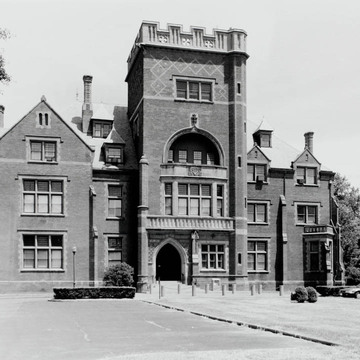This wildly exuberant Tudor pastiche in warm red brick with sandstone trim was designed by Charles H. Read, Jr., the son of a prominent local Presbyterian pastor and graduate of the University of Virginia. The influence of Jefferson's Lawn is evident in Read's placement of the institutional buildings: Watts Hall sits at the head of a grassy quadrangle, while faculty and student housing line the greensward. Read left the east end of the lawn open, just as Jefferson had done. (In both places, however, buildings would later enclose these spaces.) However, Read departed from Jefferson in a number of ways. He positioned his faculty homes to look outward from the lawn to face the outside world, symbolic of Read's idea of how ministers should approach their work. He also separated the faculty homes, which face Westwood Avenue, from the student dormitories, such as Richmond Hall, on the other side of the campus.
You are here
Watts Hall
If SAH Archipedia has been useful to you, please consider supporting it.
SAH Archipedia tells the story of the United States through its buildings, landscapes, and cities. This freely available resource empowers the public with authoritative knowledge that deepens their understanding and appreciation of the built environment. But the Society of Architectural Historians, which created SAH Archipedia with University of Virginia Press, needs your support to maintain the high-caliber research, writing, photography, cartography, editing, design, and programming that make SAH Archipedia a trusted online resource available to all who value the history of place, heritage tourism, and learning.

